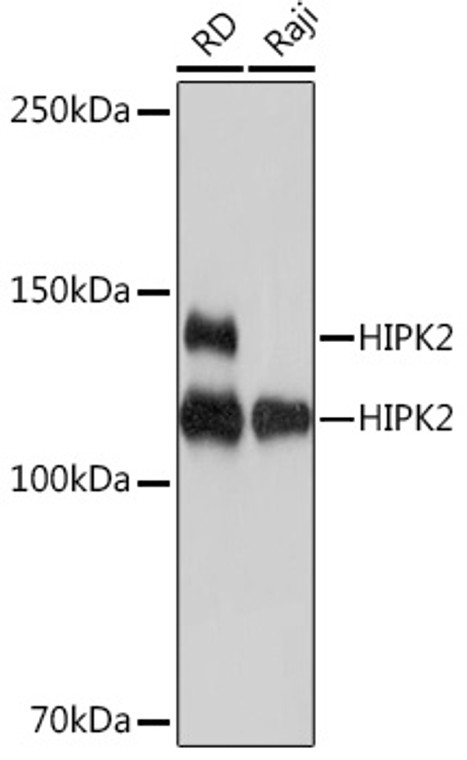| Host: |
Rabbit |
| Applications: |
WB/IF |
| Reactivity: |
Human |
| Note: |
STRICTLY FOR FURTHER SCIENTIFIC RESEARCH USE ONLY (RUO). MUST NOT TO BE USED IN DIAGNOSTIC OR THERAPEUTIC APPLICATIONS. |
| Short Description: |
Rabbit monoclonal antibody anti-HIPK2 (100-200) is suitable for use in Western Blot and Immunofluorescence research applications. |
| Clonality: |
Monoclonal |
| Clone ID: |
S0MR |
| Conjugation: |
Unconjugated |
| Isotype: |
IgG |
| Formulation: |
PBS with 0.02% Sodium Azide, 0.05% BSA, 50% Glycerol, pH7.3. |
| Purification: |
Affinity purification |
| Dilution Range: |
WB 1:500-1:2000IF/ICC 1:50-1:200 |
| Storage Instruction: |
Store at-20°C for up to 1 year from the date of receipt, and avoid repeat freeze-thaw cycles. |
| Gene Symbol: |
HIPK2 |
| Gene ID: |
28996 |
| Uniprot ID: |
HIPK2_HUMAN |
| Immunogen Region: |
100-200 |
| Immunogen: |
A synthetic peptide corresponding to a sequence within amino acids 100-200 of human HIPK2 (Q9H2X6). |
| Immunogen Sequence: |
STSVTGQVLGGPHNLMRRST VSLLDTYQKCGLKRKSEEIE NTSSVQIIEEHPPMIQNNAS GATVATATTSTATSKNSGSN SEGDYQLVQHEVLCSMTNTY E |
| Tissue Specificity | Highly expressed in heart, muscle and kidney. Weakly expressed in a ubiquitous way. Down-regulated in several thyroid and breast tumors. |
| Post Translational Modifications | Autophosphorylation at Tyr-361 in the activation loop activates the kinase and promotes nuclear localization. Sumoylated. When conjugated it is directed to nuclear speckles. Desumoylated by SENP1. Sumoylation on Lys-32 is promoted by the E3 SUMO-protein ligase CBX4. Ubiquitinated by FBXO3, WSB1 and SIAH1, leading to rapid proteasome-dependent degradation. The degradation mediated by FBXO3, but not ubiquitination, is prevented in the presence of PML. The degradation mediated by WSB1 and SIAH1 is reversibly reduced upon DNA damage. Cleaved at Asp-923 and Asp-984 by CASP6 in a p53/TP53-dependent manner. The cleaved form lacks the autoinhibitory C-terminal domain (AID), resulting in a hyperactive kinase, which potentiates p53/TP53 Ser-46 phosphorylation and subsequent activation of the cell death machinery. |
| Function | Serine/threonine-protein kinase involved in transcription regulation, p53/TP53-mediated cellular apoptosis and regulation of the cell cycle. Acts as a corepressor of several transcription factors, including SMAD1 and POU4F1/Brn3a and probably NK homeodomain transcription factors. Phosphorylates PDX1, ATF1, PML, p53/TP53, CREB1, CTBP1, CBX4, RUNX1, EP300, CTNNB1, HMGA1, ZBTB4 and DAZAP2. Inhibits cell growth and promotes apoptosis through the activation of p53/TP53 both at the transcription level and at the protein level (by phosphorylation and indirect acetylation). The phosphorylation of p53/TP53 may be mediated by a p53/TP53-HIPK2-AXIN1 complex. Involved in the response to hypoxia by acting as a transcriptional co-suppressor of HIF1A. Mediates transcriptional activation of TP73. In response to TGFB, cooperates with DAXX to activate JNK. Negative regulator through phosphorylation and subsequent proteasomal degradation of CTNNB1 and the antiapoptotic factor CTBP1. In the Wnt/beta-catenin signaling pathway acts as an intermediate kinase between MAP3K7/TAK1 and NLK to promote the proteasomal degradation of MYB. Phosphorylates CBX4 upon DNA damage and promotes its E3 SUMO-protein ligase activity. Activates CREB1 and ATF1 transcription factors by phosphorylation in response to genotoxic stress. In response to DNA damage, stabilizes PML by phosphorylation. PML, HIPK2 and FBXO3 may act synergically to activate p53/TP53-dependent transactivation. Promotes angiogenesis, and is involved in erythroid differentiation, especially during fetal liver erythropoiesis. Phosphorylation of RUNX1 and EP300 stimulates EP300 transcription regulation activity. Triggers ZBTB4 protein degradation in response to DNA damage. In response to DNA damage, phosphorylates DAZAP2 which localizes DAZAP2 to the nucleus, reduces interaction of DAZAP2 with HIPK2 and prevents DAZAP2-dependent ubiquitination of HIPK2 by E3 ubiquitin-protein ligase SIAH1 and subsequent proteasomal degradation. Modulates HMGA1 DNA-binding affinity. In response to high glucose, triggers phosphorylation-mediated subnuclear localization shifting of PDX1. Involved in the regulation of eye size, lens formation and retinal lamination during late embryogenesis. |
| Protein Name | Homeodomain-Interacting Protein Kinase 2Hhipk2 |
| Database Links | Reactome: R-HSA-2032785Reactome: R-HSA-3899300Reactome: R-HSA-5578768Reactome: R-HSA-6804756Reactome: R-HSA-8939243Reactome: R-HSA-9022692 |
| Cellular Localisation | NucleusPml BodyCytoplasmStress GranuleConcentrated In Pml/Pod/Nd10 Nuclear BodiesSmall Amounts Are Cytoplasmic |
| Alternative Antibody Names | Anti-Homeodomain-Interacting Protein Kinase 2 antibodyAnti-Hhipk2 antibodyAnti-HIPK2 antibody |
Information sourced from Uniprot.org
12 months for antibodies. 6 months for ELISA Kits. Please see website T&Cs for further guidance












